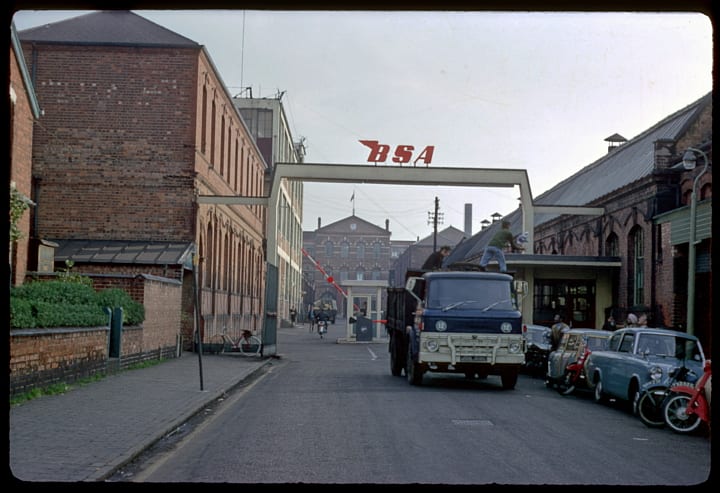 Welcome to Throwback Monday where we take a look at how things once were, or at least how certain famous
Welcome to Throwback Monday where we take a look at how things once were, or at least how certain famous cars bikes were once built. This week we’ll visit family fun day at the Birmingham Small Arms Company. At one time BSA was the largest motorcycle manufacturer in the world. Today we’re looking back on all that, and some of the people that put all those bikes together.BSA was founded in 1861 in Birmingham by fourteen members of the Birmingham Small Arms Trade Association. The company located their factory on 25 acres of land at Small Heath, in Birmingham. At the time this area was transitioning from an agrarian economy to an industrial one, a shift in which BSA played a large part. One of the main tenets of BSA’s factory plans was mechanized production rather than the more traditional at the time practice of hand-crafting. This led to improved quality, consistency and efficiency in production, and the company began to receive substantial orders in 1863. The demand for small arms was fickle however and in 1879 the factory was shuttered for a year due to lack of contract. Like any company seeing fortunes fade, BSA looked to diversification as a means of stabilizing their revenue stream. That led first to the manufacture of bicycles in the 1880s which naturally evolved into the building of motorcycles, which took place shortly after the turn of the 20th Century. The company also built cars for a time, the first in 1907 and the last just before the war in 1939. In between, they merged with Daimler, produced one of the first front-wheel drive small cars in England, and shifted production to Daimler’s plant in Coventry. While that dalliance ebbed and waned the company continued to pump out both small arms, bicycles, and motorcycles. At the outbreak of WWII the company was in fact the only one producing rifles in the UK. At its peak BSA Guns Ltd was producing thousands of hand guns, rifles, and .303 Browning machine guns per month for the war effort. They also were manufacturing the 500-cc M20 motorcycle in large numbers as it had been anointed the bike of choice by Britain’s armed forces. BSA’s motorcycles are probably the brand’s most well known legacy. The company suffered, like most in Great Britain, financial difficulties after the War, selling their bicycle division to Raleigh in 1957 and Daimler to Jaguar in 1960. The company’s motorcycle business saw increasing competition from both European makers and the Japanese, as did all of the British makers. The downward spiral ended in bankruptcy in 1972 and a government-forced sale to the Manganese Bronze Company which already owned the brands Norton-Villars and Triumph. That plan demanded significant reduction of workforce which was resisted by the workers unions and BSA along with Norton went dark the following year. Happier times are evident in this four-part video of the BSA factory in the 1950s. The first part details BSA’s Sports Day, an annual competition for the company’s workers, while the remainder delve into the factory process and how the mechanization makes the efficient building of the bikes possible. So sit back and enjoy a little Two-Wheel Tuesday on Monday as we look back on how BSA once built their bikes, and the people who built them. [youtube]https://youtu.be/ll2gBdB3AHU[/youtube] [youtube]https://youtu.be/XwjubHY2A4s[/youtube] [youtube]https://youtu.be/wTwbqo9e5W8[/youtube] [youtube]https://youtu.be/Qr7Am1ZQto4[/youtube] Image: IJMS


Leave a Reply